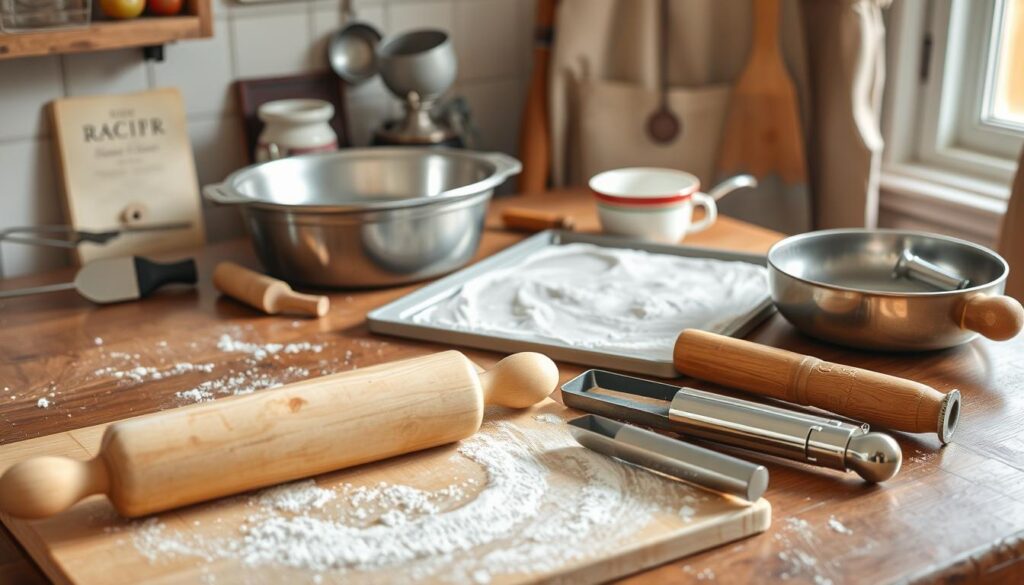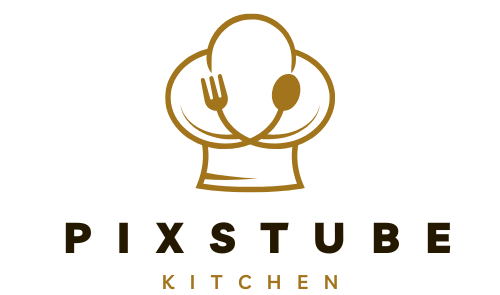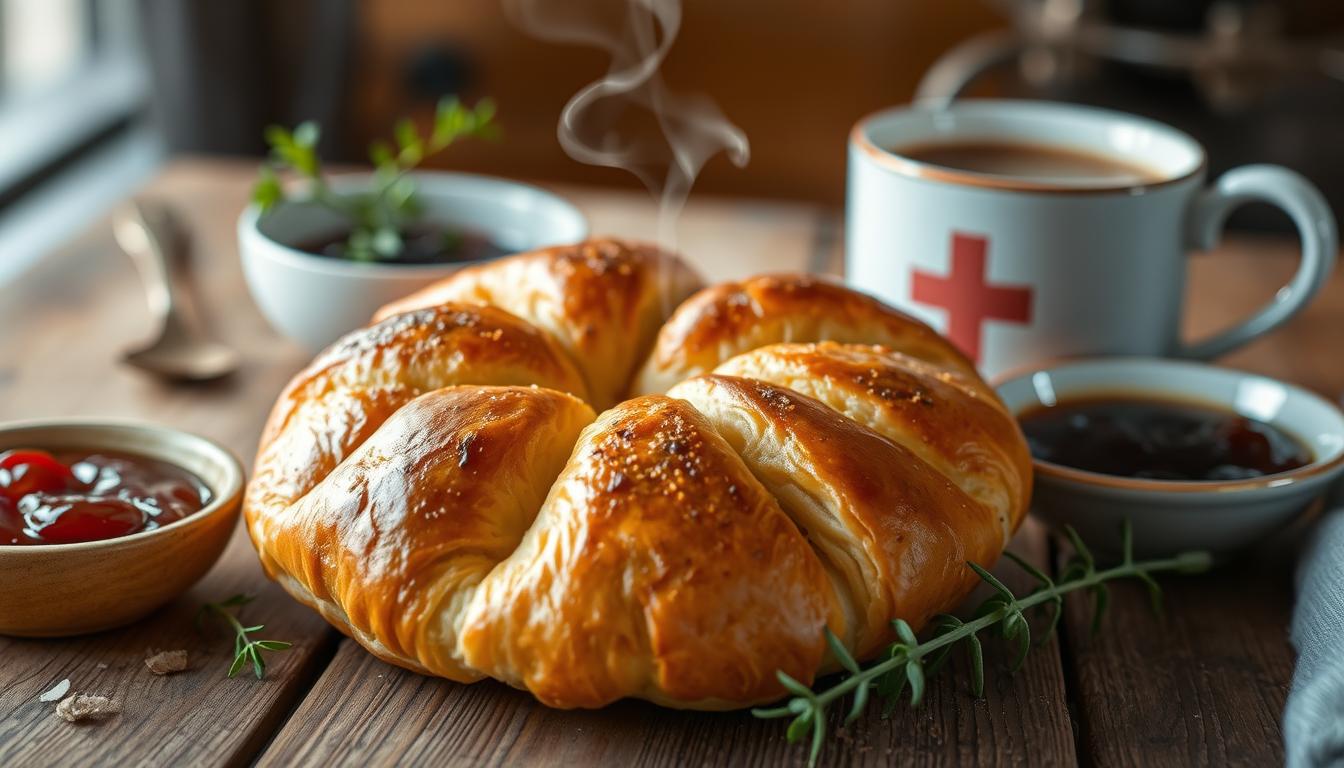Table of Contents
Every morning, I remember the first time I discovered Swiss breakfast pastries. The layers were delicate, the outside golden, and the smell of butter was amazing. It felt like I was in the Swiss Alps. This Swiss croissant recipe is more than breakfast. It’s a journey that changes your morning.
The Gipfeli Recipe is different from French croissants. It has less butter, 18-22%, and proofs faster. This makes it lighter and perfect for trying new baking styles.
Imagine your guests’ faces when they try your homemade gipfeli. Their eyes will light up. You’ll show off your baking and share a Swiss tradition.
Key Takeaways
- Discover the unique Swiss twist on traditional croissants
- Learn a professional-level gipfeli recipe from scratch
- Impress guests with authentic Swiss baking techniques
- Create a delicate breakfast pastry with perfect layers
- Explore the rich culinary heritage of Swiss baking
Understanding Swiss Morning Delights
Explore the world of Swiss breakfast pastries. Traditional Swiss baking has a rich history. It turns simple ingredients into delicious treats that everyone loves.
Origins of Swiss Breakfast Pastries
The story of Gipfeli started in the late 1800s. Swiss bakers were inspired by French croissant methods. But Gipfeli are smaller and more compact, showing the Swiss way of baking.
- Originated in Switzerland in the late 1800s
- Inspired by French viennoiserie baking techniques
- Developed as a distinctly Swiss interpretation of pastry
Cultural Significance in Switzerland
Gipfeli mean more than breakfast in Swiss culture. They are a beloved tradition that brings families together. They show the skill and care of Swiss baking.
“A Gipfeli is not just a pastry, it’s a slice of Swiss heritage”
Modern Adaptations
Today, bakers are getting creative with Gipfeli. They fill them with chocolate, jam, and cheese. These new flavors keep the pastry’s traditional charm alive.
- Optional fillings expand flavor possibilities
- Maintains traditional viennoiserie baking techniques
- Adapts to modern taste preferences
Essential Ingredients for Gipfeli Recipe

Making the perfect Swiss gipfeli starts with choosing top-notch ingredients. These ingredients turn butter laminated dough into a flaky puff pastry wonder. Your journey to authentic Swiss pastry begins with knowing each component’s role.
The heart of a great gipfeli is in the ingredients. They ensure amazing taste and texture. Let’s look at the key parts:
- Flour: 500 grams of high-protein bread flour
- Active Dry Yeast: 2 1/4 teaspoons (7 grams)
- Cold Butter: 1 cup (226 grams) for flaky layers
- Lukewarm Milk: 1 1/3 cups (315 milliliters)
- Granulated Sugar: 3 tablespoons (38 grams)
- Salt: 1 1/2 teaspoons
- Large Egg: 1 whole egg
Making flaky puff pastry needs careful attention to these ingredients. The cold butter is especially important for those delicate, layered textures in your dough.
| Ingredient | Quantity | Purpose |
|---|---|---|
| Bread Flour | 500g | Creates gluten structure |
| Cold Butter | 226g | Develops flaky layers |
| Active Dry Yeast | 7g | Enables dough rising |
Pro tip: Keep all ingredients cold during preparation. This ensures the most delicious, light, and airy gipfeli. Temperature control is crucial for those irresistible, delicate pastry layers.
Adding optional ingredients like almond paste or Nutella can make your gipfeli even better. It lets you customize this traditional Swiss treat.
Tools and Equipment for Perfect Results

Making top-notch bakery treats like gipfeli needs the right tools and equipment. Viennoiserie baking is all about precision and using the right tools for professional-quality results. Whether you bake at home or dream of being a pastry chef, the right equipment will make your Swiss pastry-making better.
Must-Have Baking Tools
For great viennoiserie baking, you’ll need these key tools:
- Precision digital kitchen scale
- Sturdy rolling pin with smooth surface
- Sharp pastry wheel or pizza cutter
- Silicone baking mat or parchment paper
- Large baking sheet with rim
- Pastry brush for egg wash
Temperature Control Equipment
Keeping precise temperatures is key in making bakery treats. Get these tools:
- Instant-read digital thermometer
- Refrigerator thermometer
- Kitchen timer with precise seconds tracking
- Bench scraper for dough manipulation
Optional Professional Tools
If you want to take your viennoiserie baking to the next level, consider these advanced tools:
- Dough docker for preventing excessive rising
- Professional-grade convection oven
- Marble pastry board for temperature control
- Graduated measuring cups and spoons
While professional equipment can improve your baking, remember that passion and technique are what truly make delicious gipfeli.
Mastering the Dough Preparation

Creating the perfect gipfeli recipe starts with understanding butter laminated dough. Your journey to making authentic Swiss pastries begins with choosing the right ingredients and preparing them carefully.
For your gipfeli recipe, you’ll need high-quality ingredients for spectacular results. Here are the key components for your butter laminated dough:
- Bread flour with 11-12% protein content
- Unsalted butter with minimum 80% milk fat
- Lukewarm whole milk
- Instant yeast
- Granulated sugar
- Salt
The secret to great butter laminated dough is in temperature control and technique. Start by mixing your dry ingredients separately from wet ingredients. Precise measurements are crucial: use 500g bread flour, 10g instant yeast, and 55g sugar.
Kneading needs a gentle touch. Mix until a smooth, elastic dough forms. Your goal is to develop gluten without overworking the dough. Aim for at least 6 hours of resting time, preferably overnight in the fridge.
Temperature management is key during dough preparation. Keep your workspace cool and work fast to avoid melting butter. Chill the dough for at least 30 minutes between folding stages to keep those flaky layers intact.
The Art of Butter Lamination
Making flaky puff pastry is a detailed process. It turns simple dough into a culinary wonder. The key is butter laminated dough, a method that needs precision, patience, and practice.
Mastering butter lamination means adding chilled butter to your dough. This creates many thin layers. This step is essential for the flaky texture of Swiss Gipfeli.
Creating Perfect Layers
To make great butter laminated dough, follow these steps:
- Use high-fat European-style butter (around 82% fat content)
- Keep butter and dough consistently cold
- Roll dough to 1/8-inch thickness
- Perform 3 rounds of folding and chilling
Common Lamination Mistakes
| Mistake | Consequence | Prevention |
|---|---|---|
| Warm butter | Butter seeps into dough | Chill butter between folds |
| Uneven rolling | Inconsistent layers | Use consistent pressure |
| Overworking dough | Tough pastry | Minimal handling |
Temperature Management Tips
Keeping your workspace cool is key for flaky puff pastry. Aim for a temperature of 60-65°F. Chill the dough for 30-45 minutes after each fold. This helps keep the butter separate and prevents it from mixing with the dough.
Learning these techniques will turn your Gipfeli into a Swiss delicacy.
Shaping Techniques for Traditional Crescents
Mastering the art of shaping croissants is key in Swiss baking. Your swiss croissant recipe will come to life with precise shaping. This turns simple dough into beautiful crescents.
To create perfect gipfeli, follow these essential steps:
- Roll out your dough into a thin, even rectangle
- Cut the dough into precise triangular shapes
- Ensure each triangle measures approximately 3 x 12 inches
- Make a small 1-inch slit at the base of each triangle
When shaping your crescents, stretch the triangle gently. This creates an elongated form. Start at the wide base, roll the dough towards the pointed tip, slightly curving the ends to form the classic crescent shape. The key is maintaining consistent tension to prevent uneven layers.
Professional bakers recommend keeping your workspace cool and handling the dough minimally. Cold butter and controlled temperature are essential in traditional Swiss baking. They help maintain those delicate, flaky layers that make gipfeli so irresistible.
Pro tip: Chill your shaped crescents for 30-45 minutes before baking. This helps them maintain their distinct shape and maximize layer definition.
Baking Temperature and Timing Guide
Creating perfect bakery treats needs precision and care. When making breakfast pastry like Gipfeli, knowing the right temperature and timing is key. It can turn a good result into an exceptional one.
Oven Temperature Secrets
For the tastiest Gipfeli, follow these professional baking tips:
- Preheat your oven to 400°F (200°C)
- Bake for 18-22 minutes
- Rotate the baking pan halfway through for even browning
Troubleshooting Common Baking Challenges
Baking breakfast pastry can have unexpected problems. Here are fixes for common issues:
- Uneven browning: Make sure your oven temperature is consistent
- Soggy bottom: Use a preheated baking sheet
- Pale crust: Brush with egg wash before baking
- Tough texture: Don’t overwork the dough
Storage and Reheating Techniques
Keep your Gipfeli fresh with these expert tips:
- Cool completely before storing
- Store in an airtight container at room temperature for 2 days
- Refrigerate for up to 5 days
- Freeze unbaked gipfeli for up to 1 month
To reheat, warm in a 350°F oven for 5-7 minutes. This will bring back that fresh taste and flaky texture.
Serving Suggestions and Pairings
Your freshly baked Gipfeli is a versatile breakfast pastry. It turns any morning meal into a Swiss culinary experience. Pair these delicate crescents with strong espresso or Swiss herbal tea for a perfect match.
Elevate your breakfast spread with Gipfeli and various accompaniments. Try fresh fruit preserves, local honey, and creamy butter. For a heartier meal, add sliced cheeses, cured meats, or a light garden salad.
For those who love to experiment, Gipfeli is a great canvas. Try ham and cheese or chocolate fillings. Each variation lets you personalize this classic pastry while celebrating its heritage. Mastering this recipe will impress your guests and deepen your appreciation for European pastry making.
FAQ
What is the difference between a Gipfeli and a French croissant?
Gipfeli are a Swiss version of the croissant. They have a different texture and shape. They are less buttery and more compact than French croissants, showing the Swiss baking style.
Can I make Gipfeli if I’m not an experienced baker?
Yes, you can make Gipfeli with practice. It’s important to follow the lamination and shaping steps carefully. Start by learning the process and don’t worry if your first tries aren’t perfect.
What type of butter works best for Gipfeli?
Use high-quality European-style butter with 82-85% fat content. This butter gives better flavor and helps create flaky layers in your Gipfeli.
How long does it take to make Gipfeli from start to finish?
Making Gipfeli takes about 6-8 hours. This includes preparation, resting time, lamination, shaping, and baking. Most of this time is spent waiting for the dough to rest and chill.
Can I freeze Gipfeli dough or finished pastries?
Yes, you can freeze both the dough and baked Gipfeli. Raw dough can be frozen for up to 1 month. Baked Gipfeli can be frozen for 2-3 weeks. Always wrap tightly to prevent freezer burn.
Are there gluten-free alternatives for Gipfeli?
Making gluten-free Gipfeli is hard because of the lamination process. But, you can try gluten-free flour blends for pastry. The texture will be different from traditional Gipfeli.
What are traditional accompaniments for Gipfeli?
In Switzerland, Gipfeli are often served with jam, butter, or coffee or hot chocolate. They’re a big part of Swiss breakfast and café culture.
How can I ensure my Gipfeli have perfect layers?
Keep everything cold during lamination. Use a marble surface if you can. Make sure your butter is cold but soft enough to fold. Careful folding and resting between turns is key for flaky layers.
Can I add fillings to my Gipfeli?
While traditional Gipfeli are plain, you can try fillings like almond paste, chocolate, or cheese. But, don’t overfill, as it can mess with rising and layering.
What’s the ideal storage method for freshly baked Gipfeli?
Store Gipfeli in an airtight container at room temperature for 1-2 days. For longer storage, refrigerate for up to 5 days, or freeze for weeks. Reheat briefly in an oven to get them crispy again before serving.

